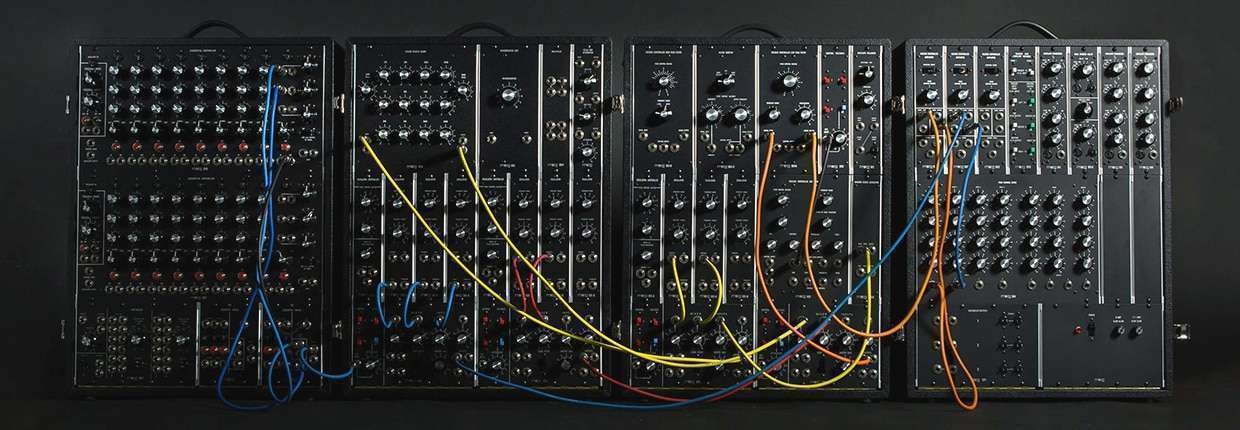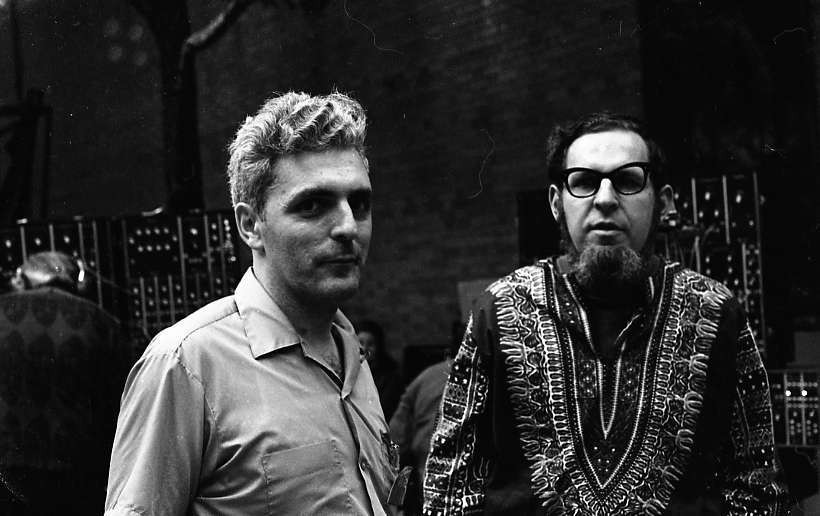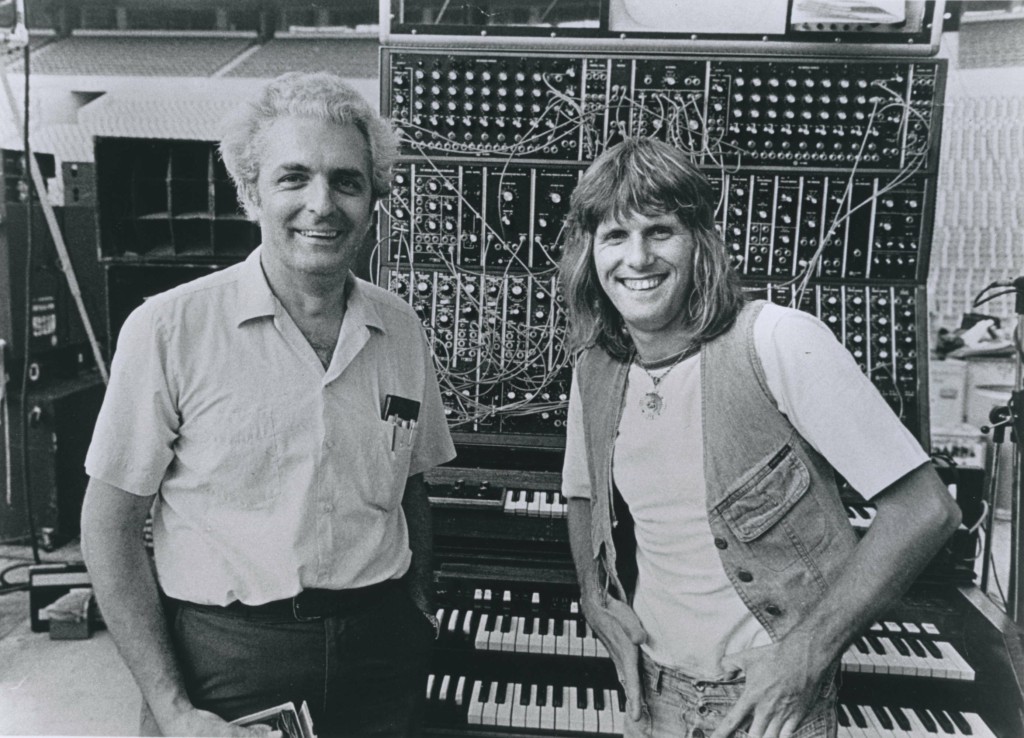Síntesis y sintetizadores
Publicado el 08/08/2022

He studied at Queens College where he gained the bachelor's degree in physics. Later on he was at Columbia University to graduate (master's degree) in electrical engineering. The Ph.D. arrived in 1965 at Cornell University.
Moog was chronologically well-positioned to get into electronic instruments.
The vacuum tube, which had been around since 1906, had just revolutionized radio and film, and had already been incorporated into electronic instruments like Lee de Forest’s Audion piano (1915), Theremin(1920), Maurice Martenot’s Ondes instrument (1928), and Friedrich’s Trautwein’s Trautonium (one of the inspirations for Moog’s Subharmonicon).

Between the thirties and the forties audio oscillators, filters, envelope controllers, and basic effects units were in existence.
In 1949, Moog built his first thereminfrom the instructions he found in a magazine.
He was fascinated with the theatrical and mysterious sounds the instrument, invented by Russian inventor Leon Theremin in the 1920s, could create.
While he was still a student, Moog founded the R.A. Moog Company as a part-time business to design and build electronic musical instruments.
He also published an article for the January 1961 issue of the magazine Electronics World.
After the issue was published, still with the help of his father, Moog sold 1,000 theremin kits out of his three-room apartment. The earned money was used to finance the University period.
Given the success, Moog began producing instruments of his own design. He started trying with a portable guitar amplifier. He did not succeed and eventually moved on to building synthesizers.
In November of 1963, at the New York State Music Conference, he met composer Herbert Deutsch while demonstrating his Theremin music kits. Deutsch had been using the Theremin for ear training, and the two immediately began discussing the possibilities of having synthesis available for musicians in their homes. ---------------

Moog designed his first synthesizers in collaboration with the composers Herbert Deutsch and Walter Carlos.
“More or less in my spare time I built two voltage-controlled oscillators, two voltage-controlled amplifiers and some kind of controller that could turn the sounds on and off and change the pitch and rates of modulation”, said Bob.
Moog's was the first synthesizer to use Attack-Decay-Sustain-Release (ADSR) envelopes, set with four different knobs.
Moog's envelope generators became a basic component of later synthesizers.
The sound was monophonic but that was enough since studio recording techniques could create whole orchestras from single notes by the late 1960s.
Moog's synthesizer also boasted the voltage-controlled lowpass filter that came to be known as the Moog Ladder Filter, which was capable of making a variety of full horn, string, and vocal timbres. ------------- The filter was patented in 1968.
The modular synthesizer prototype was given to Deutsch. It included a keyboard and two boxes: one equipped with two oscillators and an envelope generator, the other with Moog’s first iteration of his analogue filter concept.
A year later, in 1964, Moog demonstrated his modular synthesizer at the Audio Engineering Society convention, and began taking orders. ----------
Within a few years, Moog’s R.A. Moog, Inc. (the predecessor of Moog Music, Inc.) produced the Moog Modular Synthesizer models I, II and III.
In the mid-sixties pop culture began catching onto the sonic possibilities being explored by Moog, Don Buchla, and other synthesizers.
The Monkees’ Micky Dolenz was one of the first musicians to bring the Moog Modular system into the popular music realm on the band’s 1967 album Pisces, Aquarius, Capricorn & Jones Ltd.
It was also around this time that Moog’s modular system was shown at the Monterey Pop Festival.
Paul Beaver began incorporating the Moog modular sound into his film scores, starting with The Trip in 1967.
A year later, Wendy Carlos, who had studied at the Columbia-Princeton Electronic Music Center, used a Moog modular synthesizer to record her revolutionary electronic album Switched On Bach.
In 1969, The Beatles would use it on their final album, Abbey Road, and a year later in 1970, rock keyboardist Keith Emerson would add the modular Moog Synthesizer to his sonic arsenal.

After the success of Carlos's album "Switched on Bach" which was entirely recorded using Moog synthesizers, Moog's instruments leapt into commercial popular music.
The synthesizer even found its way into the world of disco by way of Giorgio Moroder’s electronic disco recordings.
Modern ambient music, particularly with Tangerine Dream and Brian Eno, also came of age as the Moog and other synthesizers became culturally ubiquitous.
Beyond these popular music movements, Moog’s commitment to giving musicians the tools they needed to sonically express themselves indirectly helped give birth to modern electronic music through the underground movements of Chicago House, Detroit Techno, and New York City’s Hip-Hop scene.
The Minimoog Model D was the world’s first portable synthesizer and served as the archetype for all electronic keyboards that followed.
First released in the early 1970’s, the instrument gained worldwide acclaim for combining the colossal sound of Moog’s large-format modular synthesizers with the accessibility of pre-wired modules.
Over the last 40 years, some of the world’s most influential artists like Trent Reznor, Gary Numan, Dr. Dre, Keith Emerson and Herbie Hancock have shaped their unique sounds and forged new musical genres using the Minimoog Model D.
This valuable sonic tool is now made available to veteran synthesists and the next generation of electronic pioneers.
Though no changes have been made to the original sound engine or audio signal path, the Minimoog Model D now includes a series of popular functional modifications that expand this legendary instrument’s sonic capabilities.
These modifications include a premium Fatar keybed with velocity and after pressure available via top panel CV jacks, a dedicated analog LFO with triangle and square waveshapes, CV outputs for pitch, gate, velocity and after pressure, basic MIDI integration, and a mixer overload modification, which when engaged, allows the Minimoog Model D to conjure thicker and far more overdriven sounds than before.
In 1971, the name of his company was changed to Moog Music, Inc., and in 1973, the company became a division of Norlin Music, Inc.
Moog served as president of Moog Music until 1977. The Micromoogwas the last synthesizer created by Moog to bear his name.
In the eighties, for a while, he served as a consultant and vice president of new product research for Kurzweil Music Systems and devoted the rest of his time to creating new electronic instruments in his Asheville workshop.
He developed the Moogerfooger, an effects module, as well as the Ethervox, his version of the theremin.
Moog's talents also attracted the attention of an Iowa firm, and he helped design and promote the Van Koevering Interactive Piano.
Meanwhile the Norlin company had folded, and Moog won a court challenge that gave him back his trademark in 2000.
Plexifilm released a documentary about Moog, simply titled Moog, in 2004. The film explored Moog's invention and featured many musicians who have used his instrument over the years.
The website ZU33 praised the film as a "stylized, wonderfully strange story of a true American maverick."
Moog was honored with Sweden's prestigious Polar Music Prize for Lifetime Achievement in 2001.
In 2002 he received a Grammy Award for Technical Achievement. "The flowering of rock music may have come via Leo Fender, Les Paul and the Gibson Guitar Co.," remarked Houston in the Salon article, "but the innovative music of the early 21st century owes far more to Moog and his imitators and successors."
Moog's awards include the Silver Medal of the Engineering Society, the Trustee's Award of the National Academy of Recording Arts and Sciences, the Billboard Magazine Trendsetter's Award, and the SEAMUS award from the Society of Electroacoustic Music in the United States.
Bob Moog is one of theUnited States Patent and Trademark Office 2013 National Inventors Hall of Fame inductees.
This is recognition awarded to “individuals who conceived, patented, and advanced so many of the great technological achievements that have changed our world.”
Bob is being recognized for Patent No. 3475623 more commonly known to Moog fans as the Moog Ladder Filter.
Using the new properties provided by transistors, the Ladder Filter was the first voltage controlled filter.
By using voltage control such as keyboards and envelopes to steer the harmonic content of music over time, the Ladder Filter allowed new ways of manipulating sound that became part of the basic grammar for a new vocabulary of musical expression.
Moog passed away on August 21, 2005 in Asheville, North Carolina. He was such a fundamental contributor to music creativity that his name will remain forever in music history as a true legend.
The information provided in this post has been gathered from following sources:
Dr. Robert Moog
Bob Moog Inducted into Inventor's Hall of Fame
Robert Moog - Moog FIlter, Lemels N-MIT
Minimoog Model D
Bob Moog’s legacy - Moog Foundation
Robert A. Moog biography - Musician’s guide
¡Únete a nosotros y obtén un 5% de descuento en tu próximo pedido!

Carro vacío